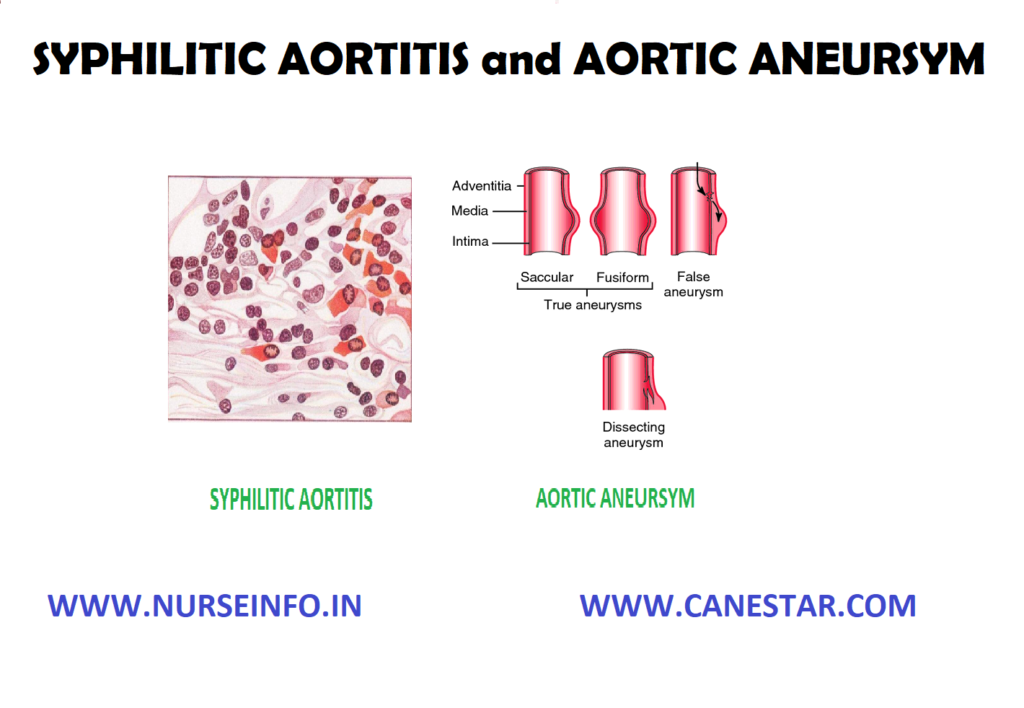SYPHILITIC AORTITIS and AORTIC ANEURSYM – Causes, Pathophysiology, Clinical Manifestation and Treatment
SYPHILITIC AORTITIS
Syphilitic aortitis is a disease of the aorta associated with the tertiary stage of syphilis infection. SA begins as inflammation of the adventitia, including the vessels that supply the aorta itself with blood and the vasa vasorum.
CAUSES
It is caused by syphilis infection, which normally occurs in older people, syphilitic aortitis typically affects those under the age of 50.
PATHOPHYSIOLOGY
Vasa vasorum (show) —- hyperplastic thickening of their walls —- restricts blood flow (causes) —- ischemia of the aortic wall
CLINICAL MANIFESTATION
- Ischemia of the outer two-thirds of the aortic wall
- Starved for oxygen and nutrients
- Elastic fibers become patchy smooth muscle cells
- Necrosis
TREATMENT
Penicillin treatments is helpful
AORTIC ANEURYSM
An aneurysm is an abnormal bulge in the wall of a blood vessel. A large bulge, more than 1.5 times the size of normal aorta, is called an aneurysm.
TYPES
- True aneuryms: in this vessels are dilate in following way:
Fusiform aneurysms: appear as symmetrical bulges around the circumference of the aorta. They are the most common shape of aneurysm.
Saccular aneurysms are asymmetrical and appear on one side of the aorta. They are usually caused by trauma or a severe aortic ulcer
Dissecting aneurysms: a bilateral out pouching in which layers of the vessels wall separate, creating a cavity
- False aneurysms: the wall rupture and a blood clot is retained in an out pouching of tissue or there connection between and artery that does not close
- Thoracic aortic aneurysms: develop in the part of the aorta that runs through the chest. This includes the ascending aorta, the aortic arch and the descending thoracic aorta
- Abdominal aortic aneurysms: develop in the part of the aorta that runs through the abdomen. Most abdominal aortic aneurysms develop below the renal arteries. Sometimes aortic aneurysms extend beyond the aorta into the iliac arteries
ETIOLOGY
The exact cause is unknown. But recent evidence includes:
- Atherosclerosis
- Hypertension
RISK FACTORS
- CAD
- Hypertension
- Hypercholesterolemia
- Hyperhomocysteinemia
- Elevated C-reactive protein
- Tobacco use
- Peripheral vascular disease
- Marfan syndrome
- Ehlers-Danlos type IV
- Bicuspid aortic valve
PATHOPHYSIOLOGY
The physical change in the aortic diameter (can occur) —- secondary to trauma, infection —- an intrinsic defect in the protein construction of the aortic wall (due to) —- progressive destruction of aortic proteins by enzymes —- enlargement of atrial walls
MANAGEMENT
Medical Management
Medical therapy of aortic aneurysms involves strict blood pressure control, but control of hypertension within tight blood pressure parameters may decrease the rate of expansion of the aneurysm.
The tetracycline antibiotic Doxycycline is currently being investigated for use as a potential drug in the prevention of aortic aneurysm due to its metalloproteinase inhibitor and collagen stabilizing properties
Surgical Management
For abdominal aortic aneurysms suggest elective surgical repair when the diameter of the aneurysm is greater than 5 cm. however, suggest medical management for abdominal aneurysms with a diameter of less than 5.5 cm.
Open Surgery
Open surgery typically involves dissection of the dilated portion of the aorta and insertion of a synthetic (Dacron or Gore-Tex) patch tube. Once the tube is sewn into the proximal and distal portions of the aorta, the aneurysmal sac is closed around the artificial tube. Instead of sewing, the tube ends, made rigid and expandable by nitinol wireframe, can be much more simply, quickly and effectively inserted into the vascular stumps and there permanently fixed by external ligature.
Endovascular Surgery
The endovascular treatment of aortic aneurysms involves the placement of an endovascular stent via a percutaneous technique (usually the femoral arteries) into the diseased portion of the aorta. This technique has been reported to have a lower mortality rate compared to open surgical repair, and is now being widely used in individuals with co-morbid conditions that make them high-risk patients for open surgery.


